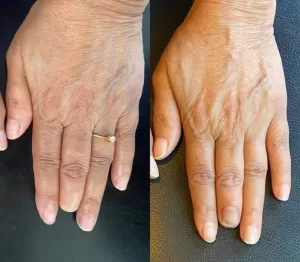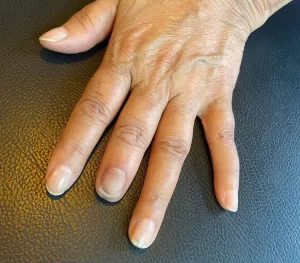Nail Bed Reconstruction Tattoo
Nail reconstruction tattoo, also known as a medical nail tattoo or nail bed camouflage tattoo, is a specialised form of paramedical tattooing used to restore the natural appearance of a damaged, discoloured, or missing nail. This advanced procedure involves implanting custom-matched pigment into the nail bed to create the illusion of a healthy, natural-looking nail plate.

What Is Used During the Procedure?
The procedure is performed using a professional tattoo machine and medical-grade, skin-safe pigments that are selected and mixed to match your natural nail tone.
Advanced shading and layering techniques are used to create a 3D effect that mimics the natural colour, shape, and texture of a real nail.
This is a non-invasive treatment — no artificial nail, gel, or acrylic is applied. Instead, pigment is gently implanted into the surface layer of the skin where the nail used to be or is visually compromised.
How Long Does a Nail Tattoo Last?
A nail reconstruction tattoo is considered a semi-permanent treatment. The results typically last 2–4 years, depending on factors such as:
- Location Matters: Nail tattoos on the fingers tend to fade more quickly than those on the toes, due to frequent hand washing and exposure to chemicals. Additionally, the skin on both fingers and toes is often thicker, which can make pigment implantation more challenging and retention less reliable. For this reason, a touch-up session is always recommended to perfect and prolong your nail reconstruction tattoo.
-
Sun exposure can cause the pigment to fade more quickly. Using SPF on the treated area will help protect the pigment and prolong your results.
-
Lifestyle and skincare habits can also affect your results. For example, using products that contain retinol or vitamin C on or near the tattooed area can cause the pigment to fade more quickly.
Touch-up sessions are recommended as needed to maintain the colour and definition.
Nail reconstruction tattoo can be used to treat a variety of conditions, including:
- Nail bed avulsion: This is a surgical procedure in which the nail is removed from the nail bed.
- Nail psoriasis: This is a chronic autoimmune disease that can cause the nails to become discolored, thickened, and malformed.
- Nail trauma: This can damage the nail bed and cause the nail to fall off.
The procedure typically takes about 1-1.5 hours, and the results can last for several years.
Dasha will first numb the area around the nail bed. Then, she will use a needle to inject pigment into the nail bed. The number of sessions required will vary depending on the extent of the damage to the nail bed.
Here are some aftercare tips for nail tattoos:

- Keep the tattooed area clean and dry.
- Apply a thin layer of moisturizer. A water-based moisturizer like Aquaphor can help keep the tattooed area hydrated and prevent it from drying out.
- Avoid picking at the scabs. The scabs will eventually fall off on their own. Picking at them can damage the tattoo and prolong the healing process.
- Wear gloves when doing activities that could get the tattooed area wet or dirty. This includes washing dishes, and gardening.
- Be patient. The tattoo will take about two weeks to fully heal. During this time, it may be a little bit sensitive and may peel or flake.
Here are some things you should avoid doing after getting a nail tattoo:
- Don’t soak your nails in water. This can loosen the ink and make the tattoo fade. Don’t use harsh soaps or lotions. These can irritate the skin and damage the tattoo.
- Don’t pick or scratch the area. This can cause the ink to bleed and the tattoo to become infected.
- Don’t expose the tattoo to direct sunlight. The sun’s ultraviolet rays can fade the tattoo.
- Avoid swimming pool, spa, or sauna for at least 3 weeks after the treatment.
